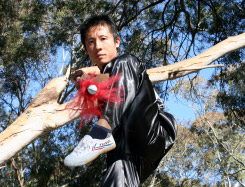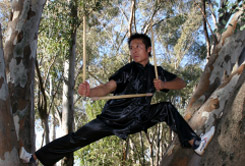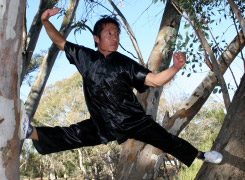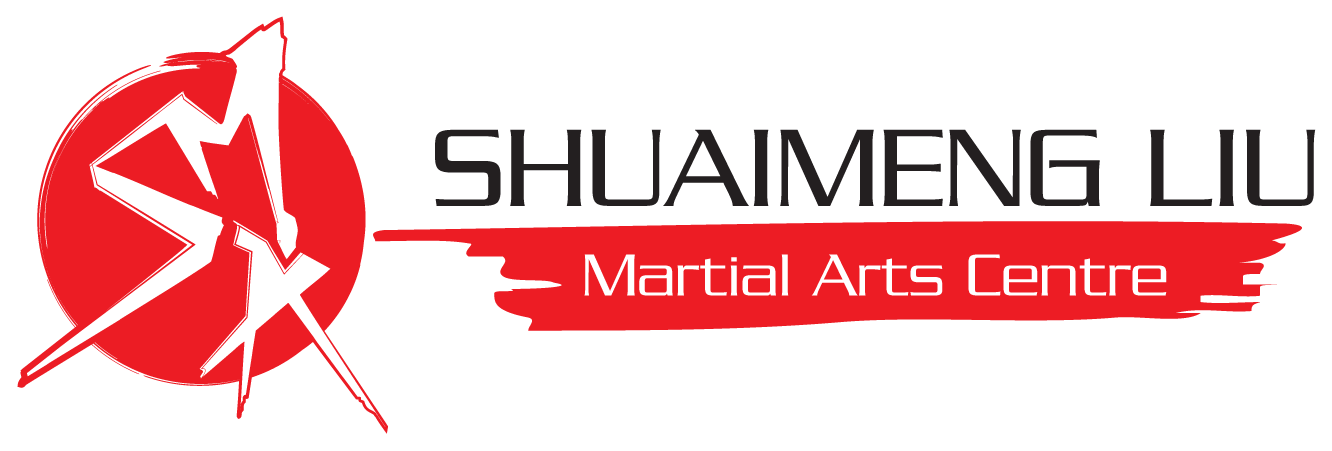Wu Shu
 Wu Shu is both an exhibition and a full-contact sport derived from traditional Chinese martial arts. It was developed in China after 1949, in an effort to standardize the practice of traditional Chinese martial arts, although attempts to structure the various decentralized martial arts traditions date back earlier, when the Central Guoshu Institute was established at Nanking in 1928. In contemporary times, Wu Shu has become an international sport through the International Wushu Federation (IWUF), which holds the World Wu Shu Championships every two years; the first World Championships were held in 1991 in Beijing and won by Yuan Wen Qing.
Wu Shu is both an exhibition and a full-contact sport derived from traditional Chinese martial arts. It was developed in China after 1949, in an effort to standardize the practice of traditional Chinese martial arts, although attempts to structure the various decentralized martial arts traditions date back earlier, when the Central Guoshu Institute was established at Nanking in 1928. In contemporary times, Wu Shu has become an international sport through the International Wushu Federation (IWUF), which holds the World Wu Shu Championships every two years; the first World Championships were held in 1991 in Beijing and won by Yuan Wen Qing.
Competitive Wu Shu: Tao Lu – “forms”
Tao Lu involves martial art patterns and manoeuvres for which competitors are judged and given points according to specific rules. The forms comprise of basic movements – stances, kicks, punches, balances, jumps, sweeps and throws, based on a culmination of different types of traditional Chinese martial art styles.
Competitive forms have time limits that can range anywhere from 20 seconds to over 5 minutes, depending on the extent in complexity of the particular external or internal styles performed. Modern Wu Shu competitors are increasingly training in aerial techniques, such as 540, 720, and even 900-degree jumps and kicks to add more difficulty and style to their form.
Shaolin Kung Fu
 The most ancient form of Chinese martial arts, the Shaolin style of Kung Fu martial arts is characterised by intense external energy, and includes forms, 25 weapons and famous styles like Tiger and Drunken Fist. The Shaolin Monastery is a Chán Buddhist temple located on Mount Song, in Henan province, China. Currently led by Abbot Shi Yongxin, the monastery was founded in the fifth century, and boasts a long-standing tradition of Chinese martial arts, particularly Kung Fu. The Shaolin Temple is the best known Mahayana Buddhist monastery to the Western world, and was also where Jiàoliàn Shuaimeng Liu called home since the age of nine, until his arrival in South Africa in 2005. In Mandarin, the word “kung fu” can be translated in the following way: “gōng” means “work” or “achievement”, and “fu” means “intensity”
The most ancient form of Chinese martial arts, the Shaolin style of Kung Fu martial arts is characterised by intense external energy, and includes forms, 25 weapons and famous styles like Tiger and Drunken Fist. The Shaolin Monastery is a Chán Buddhist temple located on Mount Song, in Henan province, China. Currently led by Abbot Shi Yongxin, the monastery was founded in the fifth century, and boasts a long-standing tradition of Chinese martial arts, particularly Kung Fu. The Shaolin Temple is the best known Mahayana Buddhist monastery to the Western world, and was also where Jiàoliàn Shuaimeng Liu called home since the age of nine, until his arrival in South Africa in 2005. In Mandarin, the word “kung fu” can be translated in the following way: “gōng” means “work” or “achievement”, and “fu” means “intensity”
A philosophical principle not strictly limited to martial arts, it speaks of individual accomplishment achieved through dedicated effort, hard work and mastery. Shaolin Kung Fu uses martial arts to instil its practitioners with six key virtues:
Generosity of spirit
Discipline and Patience
Self-control and moderation
Vigour and Diligence
Meditation and Consideration
Wisdom and Learning
The Shaolin style of martial arts is among the first to be institutionalized in China. The oldest evidence of Shaolin combat is a stele from 728 CE that describes the defence of the Temple from bandits in 610 CE, and the Battle of Hulao in 621 CE Between the 16th and 17th centuries, martial arts was established as an essential practice of the Shaolin monks, who refined the practice over centuries, becoming masters and singular authorities in the teaching of Kung Fu. Shaolin monks are particularly well-regarded for styles that employ the use of a gùn, or staff (Cantonese: “gwan”).
Training
Kung Fu training consists of learning a set of basics forms, and applying the basics to a gradual and steady development of more advanced forms and movements, some of which involve the use of traditional weapons. Additionally, students learn virtuous behaviour, spiritual understanding, and the integration of body, mind and spirit, as well as an insight into traditional Chinese culture, behavioural norms, respect and courtesy.
Qi Gong
 Qi Gong means “Life Energy Cultivation”, and is a practice of meditation that focuses on aligning breath, movement, and conscious awareness. Stemming from the teachings of Chinese traditional medicine, martial arts, and philosophy, Qi Gong is considered as an “internal” form of martial arts, which teaches practitioners how to cultivate and balance their Qi (chi), or “intrinsic life energy”. The practice consists of rhythmic breathing techniques, which are coordinated with the repetition of slow and stylised fluid movements. This is done in order to achieve a calm mindful state, whilst Qi is being visualised as being guided through the body in a controlled manner. Qi Gong is believed to help develop human potential, allow access to higher realms of awareness, and awaken one’s “true nature”.
Qi Gong means “Life Energy Cultivation”, and is a practice of meditation that focuses on aligning breath, movement, and conscious awareness. Stemming from the teachings of Chinese traditional medicine, martial arts, and philosophy, Qi Gong is considered as an “internal” form of martial arts, which teaches practitioners how to cultivate and balance their Qi (chi), or “intrinsic life energy”. The practice consists of rhythmic breathing techniques, which are coordinated with the repetition of slow and stylised fluid movements. This is done in order to achieve a calm mindful state, whilst Qi is being visualised as being guided through the body in a controlled manner. Qi Gong is believed to help develop human potential, allow access to higher realms of awareness, and awaken one’s “true nature”.
Training methods include:
Dynamic training: defined by carefully choreographed fluid movement, coordinated with breath and awareness. This style typically involves graceful movements that mimic the motions of animals, such as in the Five Animals, White Crane, and Wild Goose (Dayan) Qi Gong styles.
Static training: This involves holding still postures for extended or sustained periods of time. This type of Qi Gong draws heavily from Buddhist Yoga traditions.
Meditative training: Similarly to Static training, this involves the balancing and centring the flow of ones energy (Qi) by practicing an inward focus of breath and contemplative concentration. This form of training draws heavily from the Buddhist and Confucian philosophical traditions, emphasizing a focus on mental clarity, virtue, and self-enlightenment.
Use of external agents: agents such as ingested herbs, massaging, physical contact and interaction with animals is also emphasised as a form of Qi Gong training, for the purposes of holistic or medical treatment.
Tai Chi
 Derived from the term “t’ai chi ch’uan” (which translates as “supreme ultimate fist” or “boundless fist”) , Tai Chi is considered as an “internal” form of martial arts. It relies on slow, circular movements – gracefully performed – in order to focus the mind and attain a greater sense of control and posture over the body. Tai Chi aids in the achievement an optimal state of mental calm and clarity, by teaching the practitioner to focus one’s mind and energy purely on the movements performed. Medical studies of Tai Chi support its effectiveness as a form of exercise and an alternative form of physiotherapy, mental therapy and the management of stress, hypertension and anxiety.
Derived from the term “t’ai chi ch’uan” (which translates as “supreme ultimate fist” or “boundless fist”) , Tai Chi is considered as an “internal” form of martial arts. It relies on slow, circular movements – gracefully performed – in order to focus the mind and attain a greater sense of control and posture over the body. Tai Chi aids in the achievement an optimal state of mental calm and clarity, by teaching the practitioner to focus one’s mind and energy purely on the movements performed. Medical studies of Tai Chi support its effectiveness as a form of exercise and an alternative form of physiotherapy, mental therapy and the management of stress, hypertension and anxiety.
The low-impact nature of the art form means that it is perfect for older students, and can be practiced as a form of meditation. The artful, balletic quality of the poses and movements involved in Tai Chi are also mastered for the purposes of competitions and performances, both of which are undertaken on a regular basis by the Shuaimeng Liu Martial Arts Centre. Most modern forms of Tai Chi can trace their origins and developments from at least one of the five traditional schools: Chen, Yang, Wu (Hao), Wu, and Sun. The Shuaimeng Liu Martial Arts Centre specifically teaches Chen-style Tai Chi.
